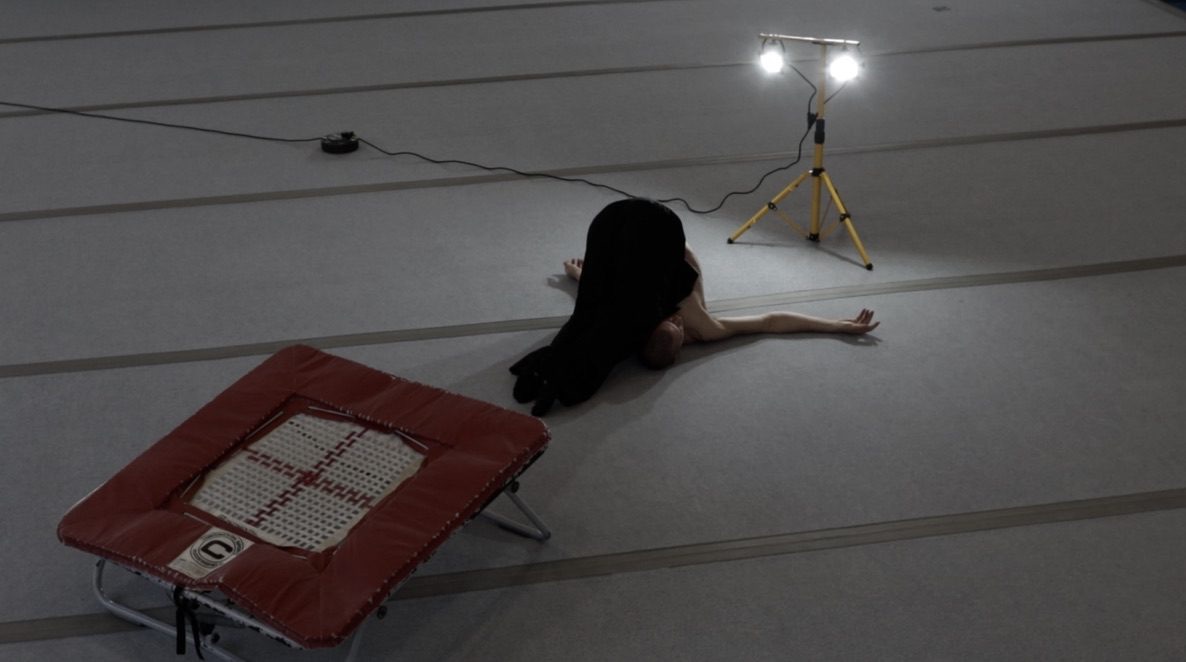Words by Maxime Swift.
We can discover a propensity for discipline quite young. Through the regimented school day, prescribed uniform, or personality-defining extracurriculars that require hours upon hours of practice, we discover that the self can be built through routine and control. But then, what happens when we try to break away from these constraints? In Bornsick – performed at Edinburgh Art Festival – Lewis Walker (after retiring from a career in gymnastics and returning to contemporary dance) experiments with discipline and narrative building through a high-intensity piece of choreography.
A whole life cycle takes place across the duration of the performance. The piece starts with Walker encased in a latex womb/egg. An alien birth sees them crawl out across the stage, dragging their legs out behind them towards the silver crashmat centre stage, like a moon landing gone wrong. It starts with a crawl, a crab walk, a bridge position with chest held high and masterfully taught, before you really get a sense of Walker’s true range and history as a champion gymnast: handstands, cartwheels and somersaults all in a cloud of chalk; with each landing, puffs of it bounce into the air, shimmering and glowing in the floodlights surrounding the stage in this enormous warehouse by the docks.
Walker performs twenty somersaults, each landing timed with the booming voice of Michele Occelli. On the final one, the stage is flooded with light and the climax of the piece is reached: in the chalk-filled gauzy light, the sound of Underworld’s Born Slippy blasts out. Walker breaks out into glitchy dance moves, occasionally jogging laps round the stage and performing elements of a floor routine, jumping and flipping to corners of the stage. By the peak of the song, they are on their knees head-banging, writhing and glistening in the flood light glow. It is the first and only time in Bornsick where Walker seems to truly have broken away from the controlled prowess of gymnastics or choregraphed routines and melted into the more spontaneous physicality of dance – dance for the rave, the club and the bedroom rather than the ballroom or stage – a kind of dance that no one teaches, you just feel it. This is the rawest part of the performance, charged with emotion; it is the ultimate juxtaposition to the piece so far, made up of repetitious laps around the stage, slow drills of known movements, learnt and rehearsed.
Ultimately, in Bornsick Walker’s personal journey through identity and queerness were clear in parts of the piece, but their relationship to their body in terms of dance and discipline were crystal clear to me as a viewer. The floodlights, the sprung floor, the laps around and around that stage all speak to a range of sports and physical activities. Spaces haunted by the spectres of coaches, trainers and PE teachers all entrusted with moulding the bodies and minds of those who pursue these disciplines. A visual language centred around the tension between the euphoric looseness and sensuality from spontaneous dance against the esteem and control of the gymnastics grew throughout the piece. Bornsick captures the way discipline and sport can lead you to find out what you are capable of, what your body is capable of, but more specifically what can be discovered about yourself when you push past this and let go of the control you’ve come to know so well.
